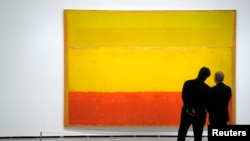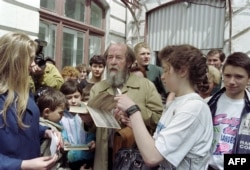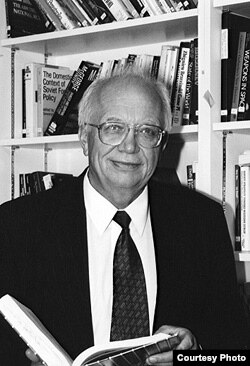WASHINGTON, D.C. —
The recent revelation by the Washington Post that the U.S. Central Intelligence Agency published and distributed Boris Pasternak’s epic novel Dr. Zhivago to undermine the Soviets made headlines.
But to Cold War historians and those who lived on the other side of the Iron Curtain, it was yesterday’s news. As it turns out, the CIA decided long ago that a good way to topple the Soviet Union was not with bombs, but canvases, symphonies and prose.
During the heyday of the Cold War in the late 1940s, the CIA began to realize that the Russian revolution’s promises of social equality had won over many Western European artists, writers, scientists.
In 1950, the CIA set up the Congress for Cultural Freedom with a goal of undermining the Soviet government and winning over the hearts and minds of Europe’s left-leaning intellectuals.
“The idea was to try and contradict notions that America was this sort of capitalist, commercial, philistine society that lacked a high cultural tradition, because the U.S. government was concerned that European intellectuals, especially, who were inclined to neutralism in the Cold War had that kind of anti-American cultural prejudice,” said Hugh Wilford, an author of several books on covert CIA operations during the Cold War era.
Books were one weapon and Dr. Zhivago was just one of many that were clandestinely subsidized.
“I think that Gulag Archipelago was even bigger than Dr. Zhivago, as an example of, from the American point of view, successful propaganda,” said Sergei Khruschev, son of former Soviet Premier Nikita Khrushchev and Senior Fellow at the Watson Institute for International Studies at Brown University.
He refers to the landmark novel by former Soviet labor camp detainee and Nobel Laureate, Alexander Solzhenitsyn which detailed hardships and abuses in Soviet prisons.
“And I would also say that about the Svetlana Alliluyeva’s [Joseph Stalin's daughter] Twenty Letters to a Friend, which was most painful to the Bresnev era,” he said, adding that Svetlana was paid nearly a million dollars for her novel.
Twenty Letters came as a devastating blow to Soviets, Khruschev said, as it exposed the flaws of Josef Stalin, the architect of Communism.
“I think it was very effective because Russians are different from the Americans,” he said. “Americans, when they watch something on TV or listen to the news, they usually believe the news.
“But in Russia, all the time there was censorship,” he said. “They never believed what they heard on the official news, so they tried to find out what was the truth and why they were lying in the Soviet Union. So all the Soviet people listened to the so-called ‘enemy voices.’”
Getting these books into the Soviet Union turned out to be relatively easy, Khruschev said.
“The people from the U.S. embassy and journalists, they liked to meet with artists, and of course they told them about the so-called “unofficial arts” in the Soviet Union, when you are talking about sculpture, about painting, music, writing, and they would usually distribute books and pamphlets around the Soviet people,” Khruschev said.
“It was illegal at that time, but in reality, everybody knew that they were doing this,” he said.
The Congress funded a host of literary and cultural magazines, including Britains’ Encounter magazine and, wittingly or not, the Paris Review.
It was the shadow behind sponsored concerts, such as a Boston Symphony Orchestra’s April 1952 performance at a Paris music festival.
The choice of music for the performance was surely no accident: The Rites of Spring by Igor Stravinsky, one of the most famous composers of his day and an avowed critic of communism.
The CIA even funded the animated film version of author George Orwell's Animal Farm.
To fund these activities, the CIA, secretly laundered money through a variety of cultural organizations in America and Europe.
Spies as art patrons
In the Soviet Union, modern art was considered to reflect the “decadence” of the West, i.e., democracy, and modern artists were viewed as subversives--including Pablo Picasso, who ironically was communist himself.
Many artists fled the Soviet Union, among them Wassily Kandinsky and Mark Rothko. The CIA dumped millions of dollars in subsidize the 1950s New York art movement known as abstract expressionism, an unrestrained and expressive style of painting as practiced by Rothko and Jackson Pollack—artists who were not particularly appreciated by Americans of the era.
The intelligence agency supported them, organizing showings of these and other painters across Europe and helping to spread abstract art as a global trend.
“In making sure that abstract expressionism, which was incontrovertedly highbrow art—it was so difficult to understand—that if it got out there, that might contradict those European notions and help get European intellectuals on our side in the Cold War,” said historian Wilford, a professor of history at California State University.
Today, it is difficult to imagine America’s spymasters as patrons of the art.
“There were some pretty sophisticated types knocking around the CIA back then,” Wilford said.
“I think they quite possibly enjoyed the role of cultural patrons because they were drawn from the sort of prep school, Ivy League classes that people like Nelson Rockefeller and [New York Herald Tribune publisher] John Hay Whitney were,” he said.
“So, it made sense in a way that this then-rather-aristocratic organization, the CIA, should be doing this,” Wilford said.
Just how effective were these activities?
“Actually, it was a pretty smart thing to be doing,” Wilford said. “And I think it worked up to a point because it did get stuff out to Europe that otherwise might not have made it.
“Because you had local affiliates in various countries around the world that made sure that local intellectuals who were friendly to the U.S. and admired it and that there were platforms for them,” he said.
But these CIA efforts, when finally revealed in the mid-to-late 1960s, did come back to haunt the intelligence agency, because it not only embarrassed the U.S., but made those intellectuals receiving CIA funds look bad, Wilford said.
The Congress, which had once boasted offices in 35 countries and nearly 300 employees, was shut down shortly afterwards.
But to Cold War historians and those who lived on the other side of the Iron Curtain, it was yesterday’s news. As it turns out, the CIA decided long ago that a good way to topple the Soviet Union was not with bombs, but canvases, symphonies and prose.
During the heyday of the Cold War in the late 1940s, the CIA began to realize that the Russian revolution’s promises of social equality had won over many Western European artists, writers, scientists.
In 1950, the CIA set up the Congress for Cultural Freedom with a goal of undermining the Soviet government and winning over the hearts and minds of Europe’s left-leaning intellectuals.
“The idea was to try and contradict notions that America was this sort of capitalist, commercial, philistine society that lacked a high cultural tradition, because the U.S. government was concerned that European intellectuals, especially, who were inclined to neutralism in the Cold War had that kind of anti-American cultural prejudice,” said Hugh Wilford, an author of several books on covert CIA operations during the Cold War era.
Books were one weapon and Dr. Zhivago was just one of many that were clandestinely subsidized.
“I think that Gulag Archipelago was even bigger than Dr. Zhivago, as an example of, from the American point of view, successful propaganda,” said Sergei Khruschev, son of former Soviet Premier Nikita Khrushchev and Senior Fellow at the Watson Institute for International Studies at Brown University.
He refers to the landmark novel by former Soviet labor camp detainee and Nobel Laureate, Alexander Solzhenitsyn which detailed hardships and abuses in Soviet prisons.
“And I would also say that about the Svetlana Alliluyeva’s [Joseph Stalin's daughter] Twenty Letters to a Friend, which was most painful to the Bresnev era,” he said, adding that Svetlana was paid nearly a million dollars for her novel.
Twenty Letters came as a devastating blow to Soviets, Khruschev said, as it exposed the flaws of Josef Stalin, the architect of Communism.
“I think it was very effective because Russians are different from the Americans,” he said. “Americans, when they watch something on TV or listen to the news, they usually believe the news.
“But in Russia, all the time there was censorship,” he said. “They never believed what they heard on the official news, so they tried to find out what was the truth and why they were lying in the Soviet Union. So all the Soviet people listened to the so-called ‘enemy voices.’”
Getting these books into the Soviet Union turned out to be relatively easy, Khruschev said.
“The people from the U.S. embassy and journalists, they liked to meet with artists, and of course they told them about the so-called “unofficial arts” in the Soviet Union, when you are talking about sculpture, about painting, music, writing, and they would usually distribute books and pamphlets around the Soviet people,” Khruschev said.
“It was illegal at that time, but in reality, everybody knew that they were doing this,” he said.
The Congress funded a host of literary and cultural magazines, including Britains’ Encounter magazine and, wittingly or not, the Paris Review.
It was the shadow behind sponsored concerts, such as a Boston Symphony Orchestra’s April 1952 performance at a Paris music festival.
The choice of music for the performance was surely no accident: The Rites of Spring by Igor Stravinsky, one of the most famous composers of his day and an avowed critic of communism.
The CIA even funded the animated film version of author George Orwell's Animal Farm.
To fund these activities, the CIA, secretly laundered money through a variety of cultural organizations in America and Europe.
Spies as art patrons
In the Soviet Union, modern art was considered to reflect the “decadence” of the West, i.e., democracy, and modern artists were viewed as subversives--including Pablo Picasso, who ironically was communist himself.
Many artists fled the Soviet Union, among them Wassily Kandinsky and Mark Rothko. The CIA dumped millions of dollars in subsidize the 1950s New York art movement known as abstract expressionism, an unrestrained and expressive style of painting as practiced by Rothko and Jackson Pollack—artists who were not particularly appreciated by Americans of the era.
The intelligence agency supported them, organizing showings of these and other painters across Europe and helping to spread abstract art as a global trend.
“In making sure that abstract expressionism, which was incontrovertedly highbrow art—it was so difficult to understand—that if it got out there, that might contradict those European notions and help get European intellectuals on our side in the Cold War,” said historian Wilford, a professor of history at California State University.
Today, it is difficult to imagine America’s spymasters as patrons of the art.
“There were some pretty sophisticated types knocking around the CIA back then,” Wilford said.
“I think they quite possibly enjoyed the role of cultural patrons because they were drawn from the sort of prep school, Ivy League classes that people like Nelson Rockefeller and [New York Herald Tribune publisher] John Hay Whitney were,” he said.
“So, it made sense in a way that this then-rather-aristocratic organization, the CIA, should be doing this,” Wilford said.
Just how effective were these activities?
“Actually, it was a pretty smart thing to be doing,” Wilford said. “And I think it worked up to a point because it did get stuff out to Europe that otherwise might not have made it.
“Because you had local affiliates in various countries around the world that made sure that local intellectuals who were friendly to the U.S. and admired it and that there were platforms for them,” he said.
But these CIA efforts, when finally revealed in the mid-to-late 1960s, did come back to haunt the intelligence agency, because it not only embarrassed the U.S., but made those intellectuals receiving CIA funds look bad, Wilford said.
The Congress, which had once boasted offices in 35 countries and nearly 300 employees, was shut down shortly afterwards.









